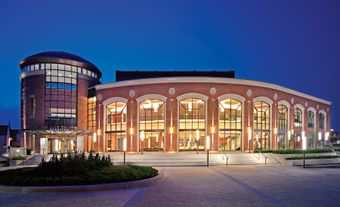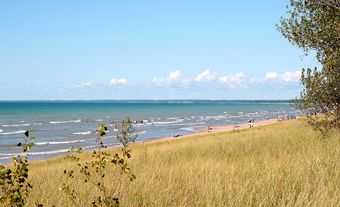Caledon, Ontario, incorporated as a city in 1974, population 76,581 (2021 census), 66,502 (2016 census). Northwest of Toronto, Caledon shares its border with nine other municipalities. Together with Brampton and Mississauga, it creates the Region of Peel. Up until recent decades, the area has been relatively rural. Today, however, it is in the midst of urbanization.
Throughout history, the Caledon area has been home to different Indigenous groups, namely the Wendat (Huron), Tionontati (Petun), Haudenosaunee and Anishinaabeg, including the Mississaugas of the Credit First Nation. The land is part of the Ajetance Purchase (1818).
Indigenous Peoples
Indigenous peoples have lived in the Caledon area for thousands of years. From the mid-15th century to the mid-17th century, the area was home to the Wendat (Huron) and Tionontati (Petun). During the Iroquois Wars of the mid-1600s, the Haudenosaunee, who at the time lived in what is now northern New York State, dispersed the Wendat and Tionontati. In the late 1600s, the Anishinaabeg (a cultural group that includes the Mississauga) moved from land north of Lakes Huron and Superior into Southern Ontario, pushing most of the Haudenosaunee back to New York State. The Mississaugas established their homes on the flats of rivers and creeks flowing south into Lake Ontario. One group, who are now known as the Mississaugas of the Credit First Nation, claimed approximately 4 million acres of territory at the western end of Lake Ontario. This territory includes what is now Caledon. Today, Indigenous peoples make up 0.8 per cent of Caledon’s population.
Settlement and Development
In 1818, James Ajetance, chief of the Mississaugas of the Credit, signed an agreement with the British colonial government. The agreement, which became known as the Ajetance Purchase or Treaty 19, surrendered 2,622 km² of Mississauga land to the Crown (see also Upper Canada Land Surrenders). In exchange, the Mississaugas of the Credit were to receive 522 pounds and 10 shillings in goods every year. In 1847, the Mississaugas of the Credit moved to their present-day location near Hagersville, Ontario, adjacent to the Six Nations of the Grand River reserve.
Land within the treaty area was divided into townships. Albion and Caledon townships were named using poetic terms for England and Scotland respectively, while Chinguacousy township was likely named for Shingwaukonse, an Ojibway leader. In 1819, the land was surveyed into lots.
Much of the land was used for agriculture, both crops and livestock. Communities including Alloa, Caledon (originally Raeburn’s Corners), Campbell’s Cross, Mayfield, Sandhill and Victoria were formed in the 19th century. One of the more unique crops in the area was ginseng, sold through export.

Mills soon dotted the Credit and Humber rivers. Communities often formed around the mills, providing services to farmers bringing their grain or wool. Alton and Bolton, communities now within Caledon’s borders, are prominent examples of early milling towns. Natural resources led to the creation of other communities. Cheltenham grew around its brickworks, which utilized clay deposits, and Belfountain developed around sandstone quarries.
By the late 1870s, three railway companies operated in the area. Industries and farmers benefited from this easier access to customers.
Two communities grew to the point that they received their own municipal governments. Bolton became separate from surrounding Albion township in 1872, incorporating as a village. Caledon East became a police village in 1913, giving it some control of local taxes, before receiving full independence in 1957.
In the 1960s, the Province of Ontario began amalgamating local governments. In 1974, Peel County’s 10 municipalities became the Region of Peel’s 3 municipalities. The Town of Caledon was created from the villages of Bolton and Caledon East, the townships of Albion and Caledon, and the north half of Chinguacousy.
Population
Caledon’s population is ethnically diverse. According to the 2021 census, prominent ethnic groups within the town include Italian (23.1 per cent), English (13.5 per cent), Indian (11.9 per cent), Scottish (10.8 per cent), Canadian (10.6 per cent) and Irish (10.3 per cent).
While Caledon is mostly rural, parts are rapidly urbanizing. The town’s population grew 15.2 per cent between 2016 and 2021, from 66,502 to 76,581 residents. However, over 75 per cent of Caledon’s landmass is Greenbelt, meaning it is environmentally and agriculturally significant land protected from urban development. This area includes many of the town’s historic communities.
While some of Caledon’s greenbelt land is still used for farming, it has also attracted Toronto’s financial and cultural elite. At various points, residents in the community have included department store owners the Eatons, Loblaw executive Galen Weston Jr., filmmaker Norman Jewison, authors Robertson Davies and Farley Mowat, then Toronto Maple Leafs owner Conn Smythe, TVO CEO Isabel Bassett and comedian Johnny Wayne. As a result, the community has numerous horse farms and golf courses, one of which will become Golf Canada’s national headquarters in 2025.

Economy and Labour Force
The transportation and logistics industry is the largest sector of Caledon’s economy, accounting for 21 per cent of all businesses and over 4,000 jobs. This includes warehouses for Amazon, Canadian Tire and UPS. Almost 16 km2 of land in Caledon is used for the aggregate mining industry — an area roughly the size of downtown Toronto. The industry involves the extraction of sand, gravel and dolomite.
Both the logistics and aggregate industries are widely opposed by many residents, due to the traffic and environmental effects. This has led many in the community to oppose the creation of Highway 413. If approved, the route would run from Vaughan to Halton through southern Caledon, and would service both industries.
Government and Politics
The Town of Caledon council has nine elected officials: a mayor, six local councillors and two Region of Peel councillors. Regional councillors and the mayor sit on both the local and regional councils.
The town is responsible for development planning, most roads, parks and recreation, libraries and fire services, among other things. The Region of Peel, which also includes Brampton and Mississauga, provides services such as water, waste and public health. The town uses the services of the Ontario Provincial Police, as opposed to the Peel Regional Police.

Cultural Life
Caledon has a number of community recreation centres and libraries. They include Alton Mill Arts Centre, the Great War Flying Museum and Caledon Equestrian Park, a former Pan Am Games venue.
The Cheltenham Badlands were formed 450 million years ago, under a sea. A boardwalk through the site was opened after crowds began damaging the rocks. The Credit River is central to both Belfountain Conservation Area (featuring a suspension bridge) and Forks of the Credit Provincial Park.
The town is intersected by the Trans Canada Trail, the Bruce Trail and the Caledon Trailway, located on a former rail line.
Residents have included Victoria Cross recipient Wallace Lloyd Algie, former Manitoba premier Howard Pawley, and Olympic soccer player Ashley Lawrence.

 Share on Facebook
Share on Facebook Share on X
Share on X Share by Email
Share by Email Share on Google Classroom
Share on Google Classroom



